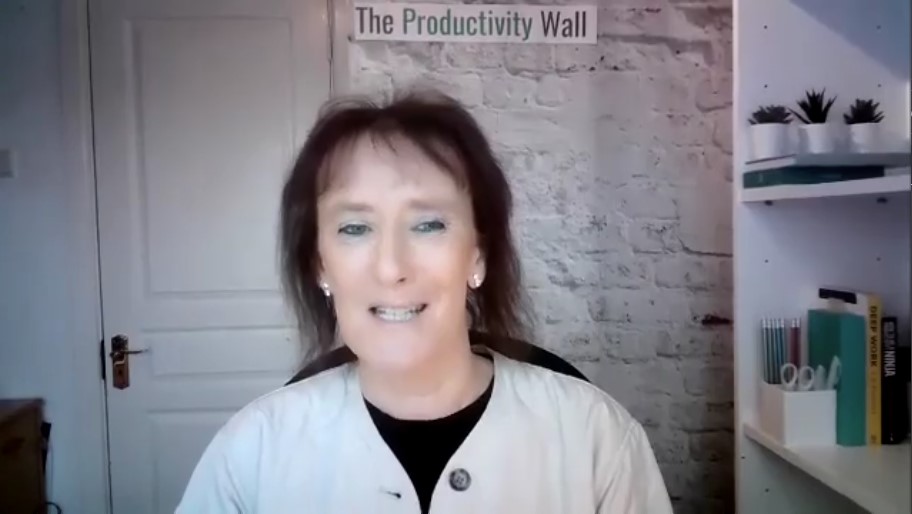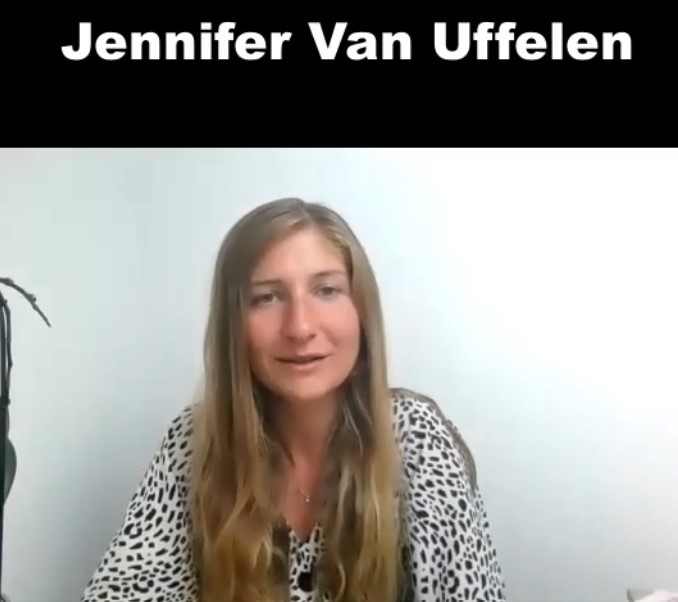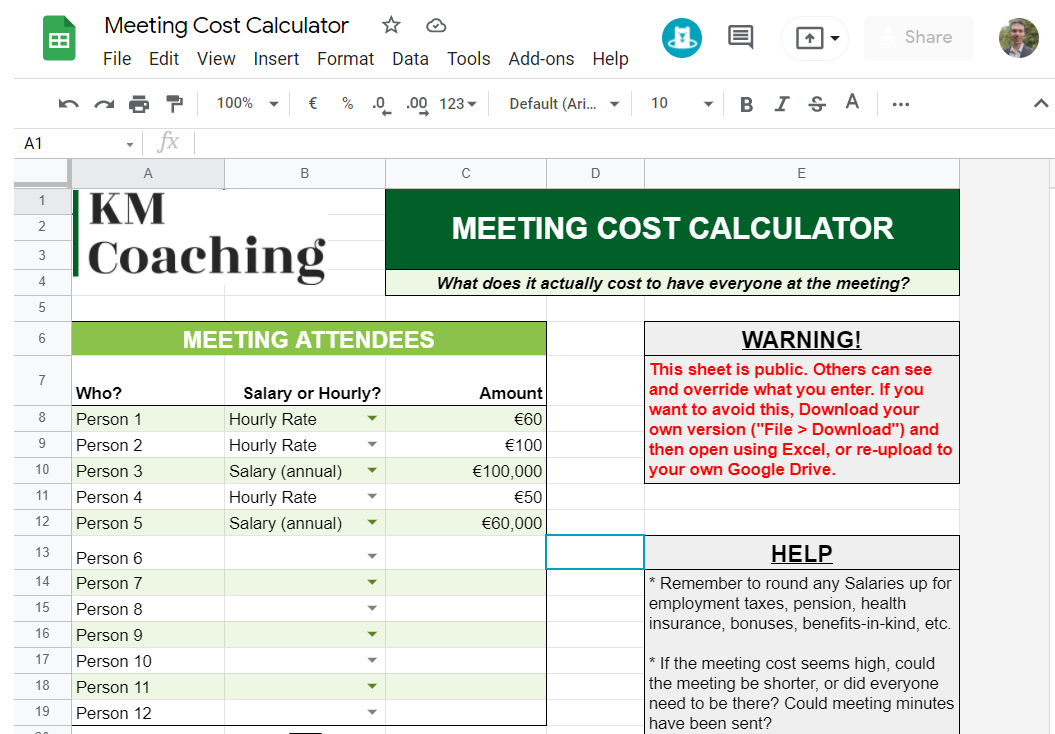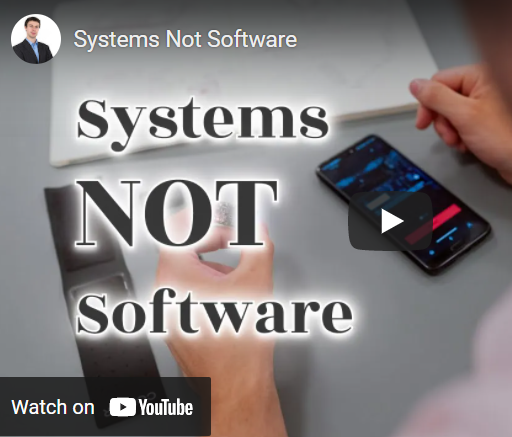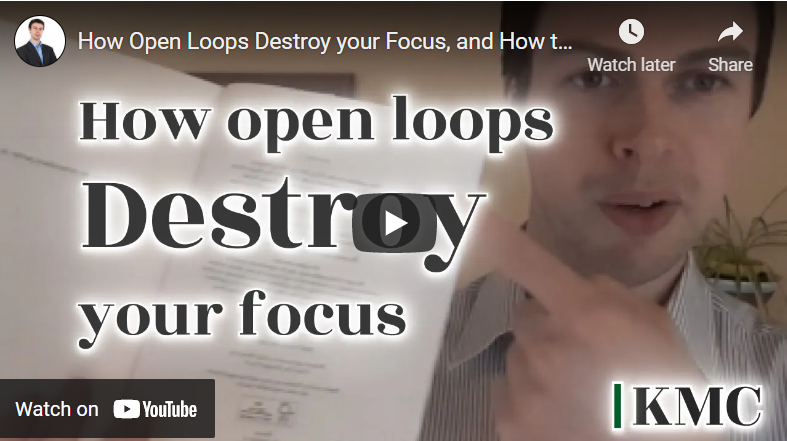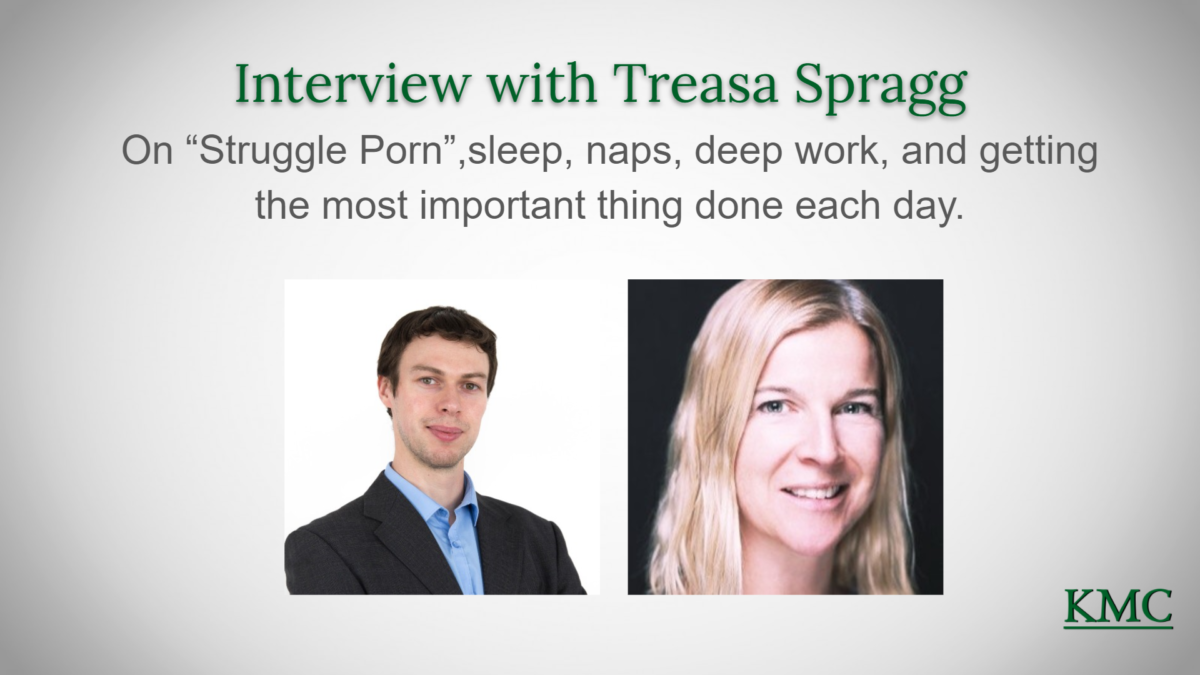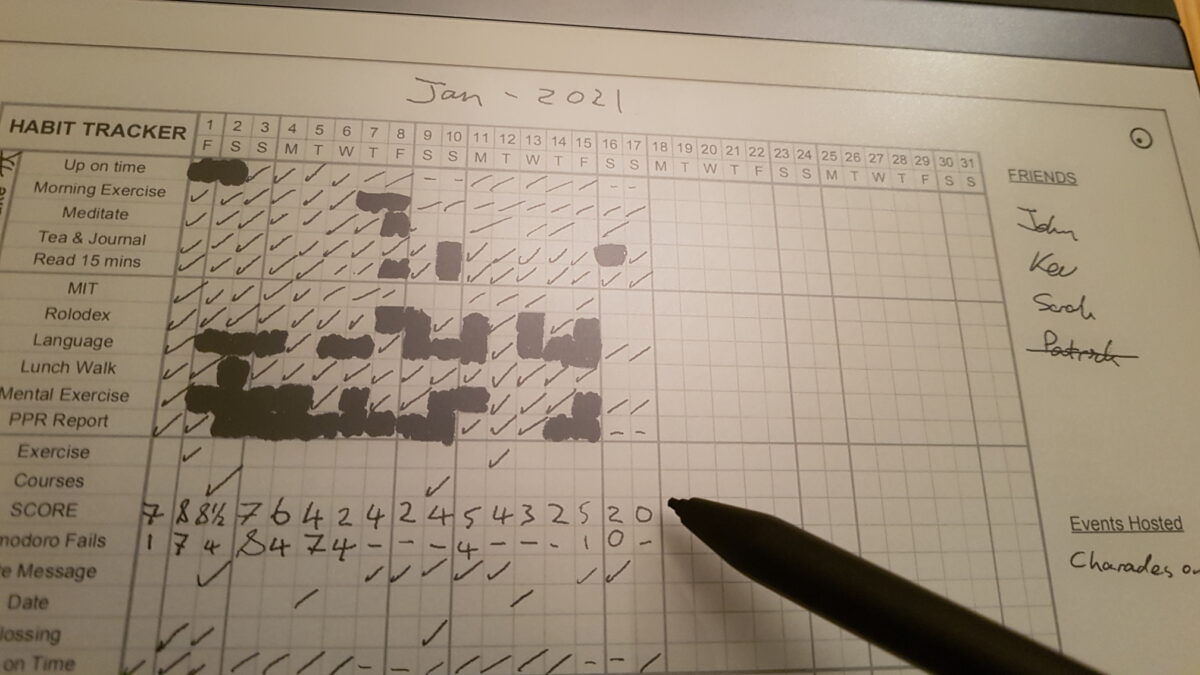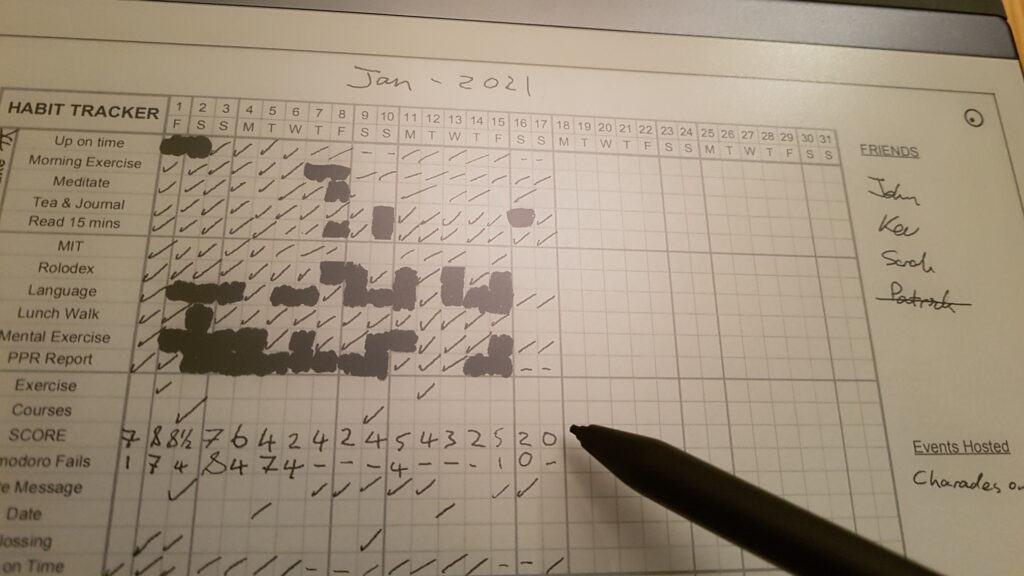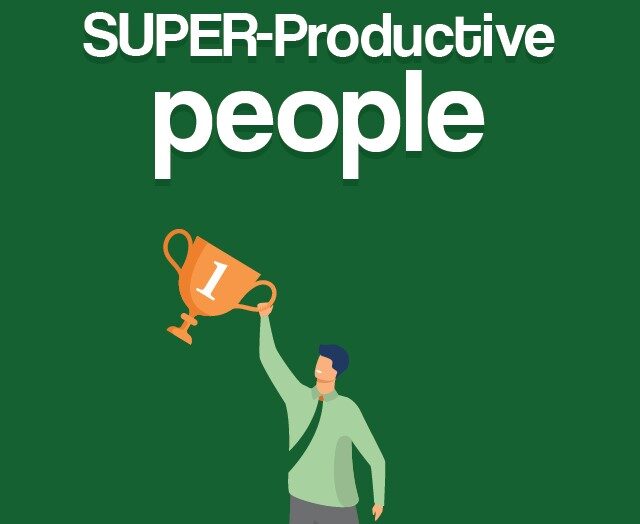Audio Transcript is below the embedded video.
Find everything on Moira Dunne at BeProductive.ie
Kevin Murphy 0:01
Okay, hello, everyone. Today I’m speaking with Moira Dunne, who’s a productivity and wellness speaker, trainer, and consultant. So thank you for coming on, Moira.
Moira Dunne 0:11
Hi, Kevin, I’m delighted to be here. Thanks for the invitation. It’s always lovely to talk productivity with a fellow productivity guru. So I’m enjoying this and looking forward to our chats.
Kevin Murphy 0:22
Hopefully, we can get a bit nerdy about psychology or tools as we go. It’s always fun.
So, Moira, I wanted to ask you, do you have a personal definition of what it means to Be Productive – I know that’s the name of your company – and could you expand on that?
Moira Dunne 0:37
Yes, I suppose there’s loads of ways of describing productivity. But the way I sum it up for people really is, to me, it’s about getting the important things you need to get done, getting those done in the time you have available to do it. So it’s about kind of having a focused purpose and then being able to use your time to get those things done. And it’s not about working long hours and working extra time to get those things done. It’s looking at the time that you want to spend at your work and making sure that you optimise that time, and that you stay focused on the most important things you need to deliver.
Kevin Murphy 1:14
That’s a great definition. I fully agree as well, like, put it into the time it’s got to… that you need it to occupy in order for you to have your work-life balance, not “look at the task list. And oh, my God is 10pm. And they didn’t get that done. And I have to go back and do it”. It’s like, “no plan it from the opposite way around. Work smarter, not harder”.
Moira Dunne 1:34
Yeah, I mean, the work life balance piece is so important. But also just to say that that’s the ideal, and that’s idealistic, and what I’ve just described and what you’ve just described, it’s really hard to do it. So. And that’s why people end up working longer hours or getting pulled off track because other people request different things from them. So, it is the definition, and then I suppose the challenge is to look at how to actually make that happen. And I often say to people, it’s not being super productive all day, every day, it’s having some productive hours in your week, productive chunks of time, and even to achieve that is better than not.
Kevin Murphy 2:14
Yeah I fully agree. The map is not the territory. You can make your ideal plan and see how close you can get, and then the real trick comes with course correcting and noticing when you’re not exactly living or working, the way you want to be, and what tools and techniques can we then apply to get back closer to the plan, which is never really 100% on-plan. There’s no perfect week, but you can get closer.
Well then Moira, I want to ask your advice for a hypothetical worker that I’ll kind of describe: So if you have someone who’s – and this has been me at different times, but it could be anyone at any different stage – who feel that they’re going through their whole days, just kind of reacting and haphazardly trying to balance just busyness versus “I must take a break”, only to arrive at the end of the day, whatever that end of the day time might be for them on that day, might even be different every day. And they’re just feeling totally unsatisfied at the end of the day they’re like “What did I even do? What did I get done?” and they want to kind of course correct, as we mentioned a minute ago, what are the first things you would have them do if they’re a client of yours describing a situation like that?
Moira Dunne 3:24
Yeah, and Kevin, that that is most people nowadays, because the workplaces are so busy and people are generally working in a very reactive, responsive mode, because there’s so much communication constantly arriving. So it’s very hard not to work in that mode. Sometimes I meet people that I train, and they’re kind of hard on themselves, because they’re thinking “I shouldn’t be working in that way”. But I’m saying just look at the environment and the way things are, of course you will. So it actually takes a bit of willpower to change it and to do something different.
The first thing I say to people is to make a plan for their week. And when I talk about a plan, I don’t mean a rigid plan that has every hour of every day mapped out because that’s just not realistic, because you need to be available to respond to the requests and the work that comes to you. But at least you know as you go into each week or even at the end of the previous week, looking ahead to the week that’s coming up to try and take control of that week. I often say “take control your week before it takes control of you”. And at least if you’ve taken some time to look into what’s happening next week, what do I need to get done? Also maybe ask the question, what would make me feel satisfied with my week on Friday, when I look back on how the week went. So try and predict what will make the week a success. And it could be that it’s just one, two, maybe three things that you want to get done in and around all the other busy requests and responsive work that you do. But by identifying those key things at the outset, they give you your priorities. They’re the things that you want to be proactive about. You’re going to try and find some time then in your diary to work on those things.
And you may have to shift that around, you may intend to do it on Wednesday morning, something else crops up, but it’ll be on your mind and then you’ll be more motivated to find time on Thursday or Friday to get it done. So just by starting with that plan gives you clarity in your head. You’re identifying what are the important things for me to achieve this week. And then that helps you then throughout the week… it’s kind of a baseline, and then everything else happens on top of that, but it means that you can keep checking into that throughout the week.
And I often just do something simple like put those three things up on a post it on the board behind me here. And that reminds me throughout the week that oh, yeah, I did intend to get those things done. Because that’s often what happens. Our work life is so busy loads and new things crop up. Sometimes by the middle of the week, we’ve forgotten what we had on our plan at the start of the week. So just by having something visual, something tangible that you’ve set out as your aim or your objective for the week, it helps you stay on track, and it helps you find time to work on those things.
Kevin Murphy 6:02
Certainly having that goal. Yeah, that would be something to keep checking in on. Like, as you said the postit which served for me might be on my monitor, for you it might be on the wall behind, or another way I have it is that I’ve a checklist, a shutdown checklist at the end of the day, to go through everything. And that’s where I check “what was my weekly goal again?”, and I actually did knock that off. So “two left and it’s Thursday. Which one might be more important? Can I get both done in the time remaining?”.
Moira Dunne 6:29
And that’s really important, Kevin kind of reassessment and juggling of the priorities. So even though you said something I was on Monday and say, that’s the most important thing I want to achieve this week, by Wednesday or Thursday, that may have changed, because other things may have cropped up and we have to be flexible. And I think that’s important that the plans are flexible. Because sometimes when I say to people make a plan, they say, well, there’s no point it’s too rigid. I can’t stick to it, you know, it keeps changing. But I say unless you have the plan, then you’re never going to get those things done, there’s a greater chance you’ll get those priority pieces of work done if you’ve planned to do them. And as you say, you may not get them all done, you may get to the back end the week, and you’re looking at the things that are still there on the list. But now you can reassess it based on the other things that have cropped up. And you can say, well, actually, I’ll just pick that one thing, if I get that done by the end of the week, I can maybe move the other things into next week. But it gives you that kind of checkpoint, that baseline that helps to keep you on track.
Kevin Murphy 7:27
Yeah, and I thought this is a good starting point. There’s lots more we can do in terms of scheduling and how one works… but it is, you know… as Ibring it back to my first question to the frantic worker who’s just right now, reacting all the time, this would be a good first place to be. And so for that worker who’ve made their plan, and as you say you need to be adaptable with you know, “okay, that third thing is not getting done” or the new priority, because boss says there’s a new priority…. And if they’re committed to doing, say, 30 days of this new planning like this, so that they can get into the habit, but they’re finding week on week that they’ve only done one thing, and they’re kind of going down that slippery slope of losing faith in this as a… as something that will work for them because they find that they have to be too reactive. You know, what would be the next thing? Would you suggest like carving a protective time daily, maybe in their schedule to work on just the things on that list before things? Or do you have other techniques or advice to support someone implementing this if they’re struggling with this first step?
Moira Dunne 8:30
Yeah, lots of things, Kevin, that first thing you’ve mentioned there carving out time. So I suppose we call it a time blocking, don’t wait, where you you look at your schedule. And I say to people look at the opportunity to get some of that planned time, but a time block where you can put in an hour and say I’m going to work on X, I’m going to work on that priority. And then maybe, you know, you have to look at your week and see the opportunity for that there’s no point in blocking that hour in the middle of a busy Wednesday morning, because you know, you’re probably not going to be able to stick to it. So it’s about looking at your week, strategically identifying the opportunity to do that time that plans time, it could be a lot of people might do a couple of power hours, maybe Tuesday, Thursday, they might start at eight before things get too crazy or maybe earlier depending on what your environment is like. And I’m blocking some time and they’re the times that they get on with their proactive their priority work before the email and the Instant Messenger and all the requests start flying in. For some people, it’s later in the day, they love to get in and do their transactional reactive work first, and then things maybe kind of quieten down later in the day and that’s when they like to block time and say between four and five in the afternoon.
For some people they might be more tired at that stage but other people find they get on a roll later in the day when they have all the other distractions cleared out of the way. Other things you can do is look at Friday’s often in an opportunity because email volumes sometimes later on Friday, a lot of people may be working shorter weeks now. So again, you know, look at Friday, block in some time Friday morning or Friday afternoon and say I’m going to work on that project then or that priority piece of work. So everybody will have a different opportunity within their week. But it’s starting to get to know your week getting to know the rhythms of it, when it’s peak when it’s quieter. And being smart, then about the time that you try and block in for your own work.
So that’s one thing, the time blocking. The other thing I suppose is, it’s probably a bigger discussion, but it’s around the responsiveness. So we’re working in busy, responsive environments, but we need to maybe start pushing back on that a little bit and saying, you know, “does, everything needs to be responded to straight away?” there will be genuinely urgent things, but then there’ll be other things that maybe could wait half an hour, an hour, a few hours, if you get back to someone by lunchtime or the end of the day. Is that, okay? So that if you switch to kind of working in that mode, it means that you’re not responding to everything straight away. And I suppose it’s starting to look at your work and identifying the high priority, the important work, the really urgent things you have to respond to. And for me, they would be things where you’re in the middle of a workflow and somebody emails you they need a response, if you don’t get back to them, then you’re going to slow down everybody else’s work. So, they’re the really origin things. That’s just one example. But then there’ll be other things that, you know, I’ve started asking people, when do you need it? I actually did it earlier today. Kevin, would you believe that somebody texted me looking for information, I was thinking that’s gonna take me an hour or two to dig that out. And I thought I just asked them, I said, When do you need us? And they said, Friday, and today’s only Monday. And I was actually thinking I’ll have to either do that later or tomorrow morning. And, because they put no timeframe on it, I immediately assumed it was it was straight away that they wanted it. And it’s interesting, you know, because they didn’t have that expectation. So now I’m like, fantastic. So I can plan it in for Thursday, or whatever, to have it ready for Friday. But I think because our work environment is becoming so urgent, and instance because email is so instant, we’ve kind of developed that way of working, where we assume everybody wants everything straight away. And sometimes they don’t. So just simply asking that question can actually be a real eye opener.
Kevin Murphy 12:25
I just want to add that when you mentioned the time blocking, as an anecdotal evidence of what you were saying and the confidence that comes with moving the needle on that, that you know, Eisenhower matrix, the most important but not really urgent thing and getting your big plans done, just by having like an hour a day or something. The confidence that comes with that is fantastic. And it really gets the ball rolling in a good way. And I was struggling to finish my master’s thesis from late last year, until January, February of this year, and thinking can I do it after the main work day. And it was a few hundred words a day or just nothing because I’m tired. But once I blocked up each morning, 90 minutes, I did 1000 words a day average and finished it in two weeks.
Moira Dunne 13:11
Yeah, so really good example. Yeah.
Kevin Murphy 13:14
it definitely has a lot of power. So what Moira said I’m just fully supporting there.
Moira Dunne 13:19
And also, and it has a lot of power, it also releases a lot of stress. Because if you feel you’re making a start on a longer term piece of work or a longer term project or something that isn’t due for a few weeks time, it means you’ll stop worrying about it just because you’ve started it. And it could be that you’re just chipping away the way you describe there. So getting a couple things done each week on it. But it also means that someone comes and asks you, you know, how are we fixed with our project? Or how are things going, you know, you’re kind of on top of it. And it also gives you opportunity to realise maybe you need input from someone else. So you have time to do that you’ve you’ve time to give them to respond as well. So you’re not doing everything at the last minute. And of course, the other thing about it is that the chances of you doing a much higher quality job is much greater because you’re not doing it under pressure. So it’s a win win.
Kevin Murphy 14:12
Absolutely, so get time blocking in place!
Moira Dunne 14:14
Yeah, it takes it takes getting into the habit of doing it though. And it can be a shift if you’re currently working in a very responsive, reactive way. So it can take time to get used to it. That’s the challenge.
Kevin Murphy 14:29
Sure, yes, give it the time. But you know, trust that the results will be there.
So yeah Moira, that was some great advice on the last one we were talking about time block planning and about interruptions and responsiveness to email and instant messenges. Both of those things are big topics with the author Cal Newport who I’m sure you’re familiar with, I can see a book behind you there. So he wrote Deep Work; a lot of people know him for that book, and more recently came out with A World Without Email. I’m not sure have you read it yet, but what do you feel about the role of email and instant messaging in our workplaces when it comes to productivity?
Moira Dunne 15:07
Well, I suppose you can look at it in two different ways. I mean, email, and instant messaging are such fantastically productive tools. And, you know, it just, it’s transformed our lives. And also the fact that we can do our email now on devices, etc, you know, you can be standing in the queue waiting for your coffee in the morning, and you can get through two or three emails, it’s unbelievably productive. The challenge is to control your email rather than have your email control you. And that is really a challenge because the volumes of email and messaging and everything to do with teams and all our online collaborative tools, now all of them really bring notifications and messaging. But the challenge is to deal with the volume.
And, of course, everything, any tool that we use, the notifications for message arrival, the notifications are by default all switched on. So every new piece of technology that you incorporate into your work life, while it helps you be productive, it also brings notifications, and alerts, and of course, that brings distraction, and linking in with Cal Newport his whole idea of deep work, I mean, I love that expression, that idea of, you know, getting into a concentrated state where you can do really deep, valuable work. His whole message, I suppose, is that if you have lots of distractions throughout the day, you’ll never really get into that deep thinking mode. So a lot of his discussion is around how to reduce those distractions. And that’s really important.
So it is important to be aware of the impact of those distractions on your ability to focus and to get that deep thinking work done. You have to balance it with though the fact that, you know, for some people, it’s really impossible to switch off those notifications to not be responsive to their email. I’ve worked with some people who get 120 emails a day, I work with people in roles that their job is to be reactive. So say someone who’s a PA to a CEO of an organisation, she has to respond instantly to every message that she gets, well, nearly every message. So while the thinking is great and Cal’s book and it can be really good to read books by people like Cal Newport, I think he’s a university lecturer, correct me if I’m wrong, Kevin… Yeah, in America, so that it is fantastic people like him have time to think about these topics and do the research and come up with good strategies. And then we can kind of learn from that and modify them. But my feeling when I read Deep Work was that it quite, it’s great and it all makes sense, if you’re in an environment where you’re a university lecturer, it’s probably not very stressful, you’re probably the master of your own destiny. So it might be easier to do some of the things that he suggests. And sometimes I feel that if people pick up a book like that, then they then feel under pressure to do it themselves. And then if they can’t, or as you said earlier, if you try something and then you can’t stick to it, you know, then that’s really demotivating. And there’s a lot of busy stressful work environments where it just wouldn’t be possible to be maybe tuning out of email for blocks of time throughout the day, because people would be so stressed if they weren’t responding to their email. But also, you know, there’d be an expectation and it wouldn’t be acceptable that they weren’t responding.
So I try and take the concepts in a book like cows and, and then give people a practical version of it, that they can then tweak to their environment. So it is I suppose around with email, looking at ways to manage that volume, somebody gets 120 emails a day like that would be your entire day, you would not really be able to get anything else done. And of course, email is how we do our job as well. So we have to spend a significant amount of time in it. One of the things is to try and distinguish between the important emails and then the ones that are lower priority that you actually can leave and respond to at a later point or even just leave them there until you need them. And, you know, I find things like the follow up flag is fantastic. So when I’m checking my email, I always used to follow up flag for things that are going to take longer.
Kevin Murphy 18:53
That’s Outlook specifically, isn’t it?
Moira Dunne 19:27
Yeah, yeah, it is. Yeah, but there’s Star in Gmail… And then what I do is I sort my Inbox by those follow up flags, and then when I come back to do an email time block for an hour or two to process my email, then I have my inbox sorted by the ones I need to follow up on. So for me with email, what I advise people to do is think of your interaction with those are you checking your email, are you processing your email? I’m very often we do the two together and then we kind of don’t do either property. So I kind of try and have numerous checks throughout the day, as many as I need to stay in touch. But when I check, I just do very quick responses, things that take up to two minutes. But anything that’s going to take longer than that, unless it’s very urgent, if it’s not very urgent, I’ll flag it for follow up. And then I’ll have email blocks throughout the day where, say, for an hour, I do all my processing. So go straight in and do all the ones flagged for follow up, clear them down. And then you know, if people have a high volume, they can do numerous time blocks throughout the day to do that processing, then check it as frequently as you need to to be responsive, you know, so, but it means that in between those times, you may have the potential to close out of it and do other things. So it’s, I think it’s looking at your interaction so that it’s not just constantly interacting with email, because then email is driving your day. And it’s impossible to get that protected time to get other things done, like the deep work that Cal mentioned.
Kevin Murphy 20:58
I want to ask you a question and let you referee the answer. Cal Newport tends to not like using the Pomodoro Technique. And for me, that’s the the top… after getting enough sleep, that’s the top productivity technique I find for any clients and any of the clients who’ve written testimonials in the end, they’ve mentioned that was a fantastic way to start me working. Which as well… if you don’t know, that involves working towards 25 Minute timers. Mostly it’s 25 minutes, you can adjust but sort of getting a half an hour of uninterrupted work – notifications off. And I find for most of my clients, one or two have said no, I have to be constantly on like the PA that you mentioned. But that ignoring email for half an hour is acceptable to them. Yes, if there’s something on Slack, I will get back to it in a few minutes. No one’s gonna yell at me for being maximum 30 minutes unresponsive. I find that’s a really good tool. Now for Cal Newport, as you said, he’s less busy, can set his own university hours… not that he’s less busy, he does a lot, but his job is less reactive… that he favours just training yourself to work for 90 minutes straight without using a 30 minute timer. He thinks 30 is too short. And it’s not deep enough. I think it really depends on the type of your work. But could you strike a balance between that or say… yeah, what does that bring up for you?
Moira Dunne 22:32
I think with both of those techniques, it’s giving people an understanding of the techniques, they can think through and go, “Well, what’s going to be the best time frame for me?” you know, because I personally would probably find 25 minutes too short. Although, if you’re looking at it from the perspective of being away from your email, it probably is long enough for people because anything longer if they don’t check, they’re going to probably feel stressed. But I guess it depends on what you’re doing. If you’re just trying to get through things not be interrupted, but it’s fairly transactional work, probably the 25 minutes is fine. If you’re trying to write a report or develop a proposal or work on something much more creative, you may need a longer period of time. So that’s probably what he’s alluding to with the 90 minutes.
But I suppose if you look at it from the perspective of your interaction with email, as you said, How long can I be away from us without checking it, and so 25 minutes, and then a five minute check is probably a good thing to aim for. And then you can go and do the same thing again for the next half an hour. So that’s a good way to break down your your time. And then of course, the Pomodoro encourages taking breaks as well doesn’t it, which is really important. But it’s hard, it can be hard to manage that as well, like five minutes can be quite short for people to take a break. So then a point drift into 10 minutes. 15 minutes.
Kevin Murphy 24:01
Ialways call it five ish.
Moira Dunne 24:04
Yeah, it’s hard to be too rigid with it. I know a lot of students use that don’t they for studying?… the Pomodoro Technique as well.
Kevin Murphy 24:13
The best students do. Yep. As you say, if you’re coming at it from people who are like, I have to have email on then say, “Well, can you try 25 with it off?”, and then you’re allowed check it for five. It’s even built into this. But you have to remind that a very important part of it is to get that rest and get out of the chair and physically get your energy back is kind of key in the Pomodoro as well. It’s not meant to be a five minute email check. But it is a perfect time to just quickly check. “Nothing there. Good. Sanity restored. Let me get a glass of water. Come back”. And yeah, it’s very good in that way. Everything I think needs to be adapted to what people are doing.
Moira Dunne 24:48
Exactly. Yeah. Yeah.
Kevin Murphy 24:49
There’s good on both sides. And as Cal says, getting to 90 minutes, that’s great if you’re trying to write a book or get really deep into a programming problem or something like this. Yeah, for sure. Adopting.
Well Moira, today’s Monday, the 29th of November, coming into the Christmas period, and even like looking at the end of our years, and what are we going to start next year with new year’s resolutions, I’m certainly starting to think of a few for myself. So even already, maybe I should start them sooner. So no need to wait till January. But on that topic, what advice would you be giving to people who are thinking of what resolutions to come up with. And whether they’re looking at this video, just a few days before New Year’s or even the first days of January, when they’re planning the resolutions that they’re going to do? What sorts of goals should they be setting? Can be very broad, but also how specific or what techniques or ways of planning their their week and their month would help them achieve whatever goals they do set?
Moira Dunne 25:53
Yeah, resolutions, Kevin, it’s an interesting topic, because everybody sets them every year, people are very keen and motivated at the start of the year to set the resolutions. But actually, when you stop and look at it and think about it, you know, why do we put all that pressure on ourselves beginning in January, and then we probably don’t really set resolutions later on in the year. I remember reading an article a few years ago, where someone said, “take one thing each month” so plan out the year and make a different resolution each month. So rather than making a list of 10 things to do in January, to actually spaced them out and maybe have a theme for each month, there’s something that you’re aiming to change or do and month, by month by month. So everything is condensed into the start of the year.
Because actually, if you look at the stats around resolutions that are set, and how many are actually implemented and achieved, the stats are alarmingly poor. So I think that’s partly because of the time of year. So while we have the enthusiasm in January because we feel it’s a fresh start, it’s actually probably one of the most challenging times of the year to give something up or to try something new that’s challenging, you know, we’ve just come out of the Christmas period, it’s dark evenings, the weather is poor. So you think of all those things, and we’re trying to just get our heads back into work, it can actually be really challenging, which is why so many of them fail. So having said all that, if you do set some resolutions, first of all, I would say just set one, or maybe two, and for January, so you know, don’t bite off too much and, take that first resolution. The key thing to implementing something and actually making it happen is to make a plan around it.
Because what’s the expression; a resolution without a plan is just a wish. So it’s just something notional in your head. And we know from even setting objectives in the business environment, if we take a high level objective, unless it’s actually broken down and drilled down into a plan of the work that actually needs to be done. And turned into a list of actions that work never gets achieved. So it’s kind of the same with resolution. So say, if we take an example, like, “I want to get fit in 2022”. So you know, that’s fine. That’s a really good resolution. So you might have that in your list. But if you actually get into January getting into the first week, or two or three, that resolution is not tangible enough for you actually to do anything about it’s like I must get fish. Well, I’ll leave it the next week, because it’s all a bit too vague. Whereas if you actually take that resolution, say, Okay, what does that actually mean? Which particular aspect of fitness? Am I looking at? Is it swimming isn’t running, etc. So even in your head, you might know, yeah, I’m going to start running, but then kind of drill down into what what do I actually need to do to make that happen, I might need to get new running shoes, I might need to join a running club, maybe I’ll download a running app, I’ll look for some race dates in the middle of the year and maybe work backwards and make a training plan. So now you’re into a list of very tangible actions. And it’s much easier to pick one of those things off every day or every week throughout January. So that you’re starting to actually move towards something very productive. So taking it from that high level down into a plan, which is really just a brainstorm of the actions that you need to take, that can really help you get started and help you maybe map out when you’re going to do those things. And then the other thing with resolutions that I would encourage people to do is ask yourself, “what will stop me doing this? What will pull my plans off track?”. Maybe it’s something you tried to do last year, and you didn’t stick to it. So kind of reflect on that and say, “Well, what were the barriers? What got in the way?” And maybe it’s I was trying to run in the mornings and I just didn’t have the motivation, you know, getting up early in the morning. So it just never happened. So then reflect on that and say, “right, well, I’m going to do something different this time”. So try and give yourself the best chance of success by considering what could get in the way of that, what the barriers could be, and what you can do to avoid that, so you have a better chance of achieving that resolution.
Kevin Murphy 30:11
Yeah, make it easy as possible as well. So to take Atomic Habits that James Clear book, he has a few steps, but one of them being make it easy. Or if you’re trying to give up a habit, make it hard. Like, yes, don’t have alcohol in the house if you’re giving up alcohol, make that hard. Or, conversely make it easy to give it up. Are you giving up smoking and “I only smoke when I’m drinking or in a social situation”, well, maybe you need to not go to the pub for January. And yeah, make it easy. Don’t put yourself in the environment.
Moira I had to ask; the Productivity Wall it’s there behind you. I noticed there’s nothing on it. This is a post-2pm call this has been so you had everything done in the morning, or what’s the story with that?
Moira Dunne 30:51
Yeah everything is done. Off the wall. It’s used really for planning things but I would often put up, as I mentioned earlier, some post it notes with the key priorities for the week. Or it could be just reminders as things crop up. Or I often use it to plan something out like we talked about resolutions, breaking down the high level resolution, break it down, I’d often use the stickies. So it is more of a brainstorm wall than one that has the plan there all the time. So tends to change a lot. I love having a space where I can stick things off because it helps with the visual. And I’ve even used this with people now online, you know, because even if we’re discussing something, we can take the stickies and put them up behind. So the visual tends to spark creativity, I think.
Kevin Murphy 31:39
I suppose your clients, if the client sees the same post it on the wall behind you next week, they’re keeping you accountable to it.
Moira Dunne 31:46
Yeah, exactly. Yeah, accountability is key as well.
Kevin Murphy 31:49
Exactly. Well, Moira, it’s been a really, really good discussion. There’s a tonne of tools and techniques. And even for myself, I’ve picked up a lot and been motivated to, to get myself back on track with some of your techniques for for January in the New Year’s resolutions. So where can people learn more from you, and I understand you the course coming up? Not released yet, but it won’t be too long after these videos are up…
Moira Dunne 32:14
So my website is BeProductive.ie. And that’s a good space for lots of productivity resources, and inspiration and motivation and tips. And there’s a resource section in it with lots of templates that people can download that can help them to plan out their week, to set priorities. We’ve got also got some planners there around goal setting and resolutions, which could be useful in the new year. There’s as a blog section as well. So there’s blogs on a lot of the topics we discussed today. So if people want more detail, particularly around email and how to manage the interaction with email… So you can connect in there. Also, you can follow me on the social media channels, so I’d be pretty active on Twitter, and LinkedIn, and Facebook and Instagram to a lesser extent, but we’re there and have a presence. So connect in there and you can keep up to date on what we’re doing. And then as you mentioned, Kevin in the new year, we’re just finalising a self paced, masterclass, that is a course that people can do online, they can sign up for it. It has six modules within it. And lots of tools and technology and templates to help people kind of change their productivity approach. So it’s entitled “How to Turn busy into productive”, so gives people lots of different tips on how to move from that busy working mode into a more productive modes. As I say the six modules, but it also has the option of a coaching session with me at the end of the masterclass. So while the learning is self paced, then you can have that one to one coaching session at the end, which gives people a chance to make their own individual plans going forward. So that will be coming on stream on the website early next year.
Kevin Murphy 34:08
Sounds awesome. Check out BeProductive.ie for more on that. And I know you have a newsletter there as well. So I’m sure you’ll fill people in who are subscribed to that.
Moira Dunne 34:17
Exactly. Yeah.
Kevin Murphy 34:18
It’s been great talking to you Moira. So thanks very much and looking forward to our next discussion whenever it is.
Moira Dunne 34:24
Great. Thanks, Kevin. I really enjoyed it and best of luck with your video series.
Kevin Murphy 34:29
Cheers

